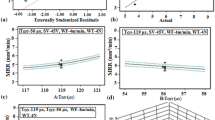Abstract
The objective of this experimental investigation is to reveal the individual effect of wire electrical discharge cutting (WEDC) process parameters, namely discharge energy density, wire feed rate, spark frequency, wire tension, and spark gap voltage on average crater depth, material removal rate (MRR), and metallographic changes of Ni55.95Ti44.05 shape memory alloy (SMA). The analysis of crater size during material removal in WEDC has been also discussed in this study. The three-dimensional surface topography at higher discharge energy density divulges the formation of deeper and wider craters with high surface roughness on the machined surface compared to lower discharge energy density. MRR and average crater depth increase with the increase in discharge energy density and decrease with the increase in spark frequency and spark gap voltage, whereas wire feed rate and wire tension have the trivial effect. The analysis of X-ray diffraction peaks of the machined surface shows the presence of various compounds such as NiTi, TiO, TiO2, Ni4Ti3, CuZn, Cu2NiZn, NiTiO3, and NiZn and tensile residual stress.










Similar content being viewed by others
References
Jani JM, Leary M, Subic A et al (2014) A review of shape memory alloy research, applications and opportunities. Mater Des 56:1078–1113
Manjaiaha M, Laubscher RF, Narendranath S, Basavarajappa S, Gaitonde VN (2016) Evaluation of wire electro discharge machining characteristics of Ti50Ni50−xCux shape memory alloys. J Mater Res 31:1801–1808
Manjaiah M, Narendranath S, Basavarajappa S (2014) Review on non-conventional machining of shape memory alloys. Trans Nonferrous Met Soc 24:12–21
Shandilya P, Bisaria H, Jain PK (2018) Parametric study on recast layer during electric discharge wire cutting (EDWC) of Ni-rich NiTi shape memory alloy. J Micro Manuf 1(2):134–141
Velmurugan C, Senthilkumar V, Dinesh S et al (2017) Machining of NiTi-shape memory alloys—a review. Mach Sci Technol 22(3):355–401
Bisaria H, Shandilya P (2018) The machining characteristics and surface integrity of Ni-rich NiTi shape memory alloy using wire electric discharge machining. In: Proceedings of the institute mechanical engineers Part C: journal of mechanical engineering science. https://doi.org/10.1177/0954406218763447
Weinert K, Petzoldt V, Kotter D (2004) Turning and drilling of NiTi shape memory alloys. CIRP Ann Manuf Technol 53:65–68
Guo Y, Klink A, Fu C et al (2013) Machinability and surface integrity of Nitinol shape memory alloy. CIRP Ann Manuf Technol 62:83–86
Bisaria H, Shandilya P (2017) Experimental studies on electrical discharge wire cutting of Ni-rich NiTi shape memory alloy. Mater Manuf Process 33(9):977–985
Sindhu MK, Nandi D, Basak I (2018) Electric discharge phenomenon in dielectric and electrolyte medium. Adv Manuf. https://doi.org/10.1007/s40436-018-0221-1
Bisaria H, Shandilya P (2019) Experimental investigation on wire electric discharge machining (WEDM) of Nimonic C-263 superalloy. Mater Manuf Process 34(1):83–92
Soni H, Narendranath S, Ramesh MR (2018) Experimental investigation on effect of wire electro discharge machining of Ti50Ni45Co5 shape memory alloys. Silicon. https://doi.org/10.1007/s12633-018-9780-9
Gostimirovic M, Kovac P, Sekulic M et al (2012) Influence of discharge energy on machining characteristics in EDM. J Mech Sci Technol 26:173–179
Punturat J, Tangwarodomnukun V, Dumkum C (2014) Surface characteristics and damage of monocrystalline silicon induced by wire-EDM. Appl Surf Sci 320:83–92
Giridharan A, Samuel GL (2015) Analysis on the effect of discharge energy on machining characteristics of wire electric discharge turning process. Proc IMechE Part B J Eng Manuf 230(11):2064–2081
Alvarez JLG, Greene JE, Turkovich BFV (1973) Study of the electro-erosion phenomenon of Fe and Zn. J Manuf Sci Eng 95(4):965–971
Wang BJ, Saka N, Rabinowicz E (1992) Static-gap, single-spark erosion of Ag-CdO and pure metal electrodes. Wear 157(1):31–49
Mamalis AG, Vosniakos GC, Vaxevanidis NM, Prohaszka J (1987) Macroscopic and microscopic phenomena of electro-discharge machined steel surfaces: an experimental investigation. J Mech Work Technol 15(3):335–356
Ghosh A, Mallik AK (2010) Manufacturing science. East-West Press Pvt. Ltd., New Delhi
Yeo SH, Kurnia W, Tan PC (2008) Critical assessment and numerical comparison of electro-thermal models in EDM. J Mater Process Technol 203:241–251
Jilani ST, Pandey PC (1983) An analysis of surface erosion in electrical discharge machining. J Wear 84(3):275–284. https://doi.org/10.1016/0043-1648(83)90269-7
Jilani ST, Pandey PC (1982) Analysis and modelling of EDM parameters. Precis Eng 4(4):215–221. https://doi.org/10.1016/0141-6359(82)90011-3
Salonitis K, Stournaras A, Stavroupoulos P, Chryssolouris G (2009) Thermal modeling of the material removal rate and surface roughness for die-sinking EDM. Int J Adv Manuf Technol 40(3–4):316–323. https://doi.org/10.1007/s00170-007-1327-y
Giridharan A, Samuel GL (2017) Investigation into erosion rate of AISI 4340 steel during wire electrical discharge turning process. Mach Sci Technol 2:287–298
Sharma P, Chakradhar D, Narendranath S (2013) Effect of wire material on productivity and surface integrity of WEDM processed Inconel 706 for aircraft application. J Mater Eng Perform 25:3672–3681
Nain SS, Garg D, Kumar S (2018) Evaluation and analysis of cutting speed, wire wear ratio, and dimensional deviation of wire electric discharge machining of super alloy Udimet-L605 using support vector machine and grey relational analysis. Adv Manuf 6:225–246
Acknowledgements
The author would like to acknowledge ACMS Department, IIT Kanpur, Kanpur, for providing optical profiler and XRD facility for achieving this work. The author would also like to thank AMD, MNNIT Allahabad, for providing X’PERT software.
Author information
Authors and Affiliations
Corresponding author
Additional information
Technical Editor: Márcio Bacci da Silva, Ph.D.
Publisher's Note
Springer Nature remains neutral with regard to jurisdictional claims in published maps and institutional affiliations.
Rights and permissions
About this article
Cite this article
Bisaria, H., Shandilya, P. Study on crater depth during material removal in WEDC of Ni-rich nickel–titanium shape memory alloy. J Braz. Soc. Mech. Sci. Eng. 41, 157 (2019). https://doi.org/10.1007/s40430-019-1655-5
Received:
Accepted:
Published:
DOI: https://doi.org/10.1007/s40430-019-1655-5



